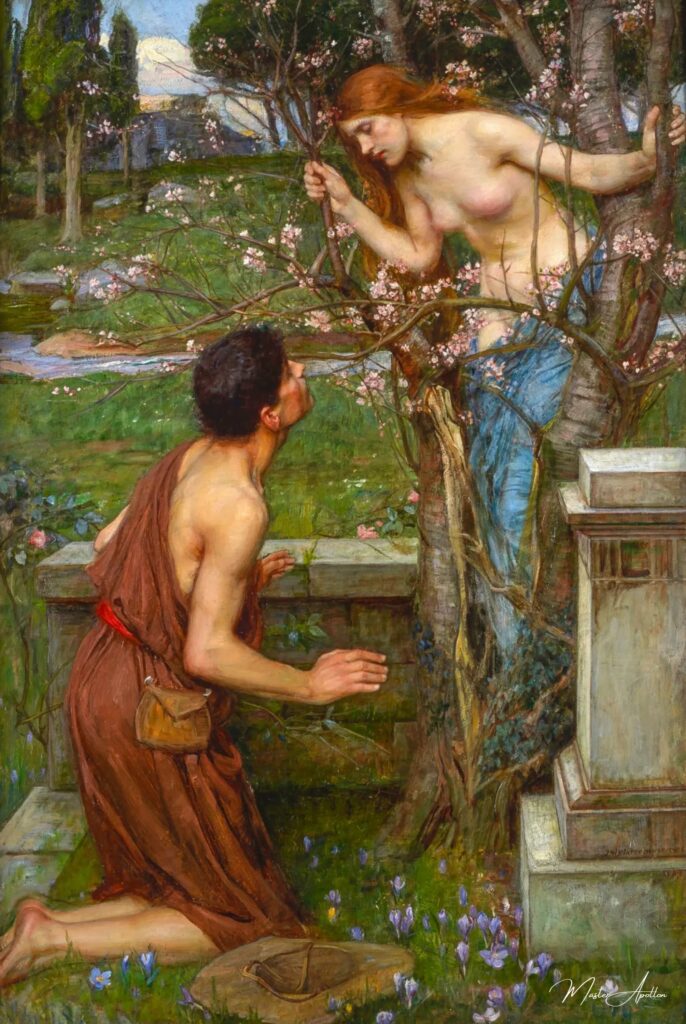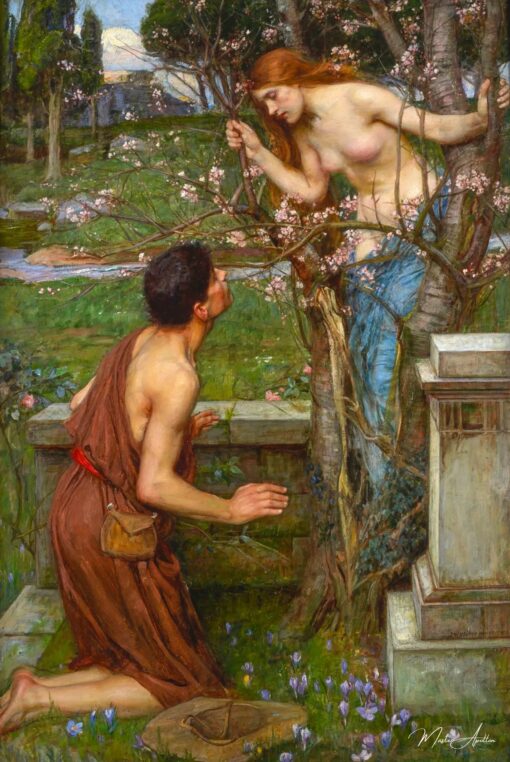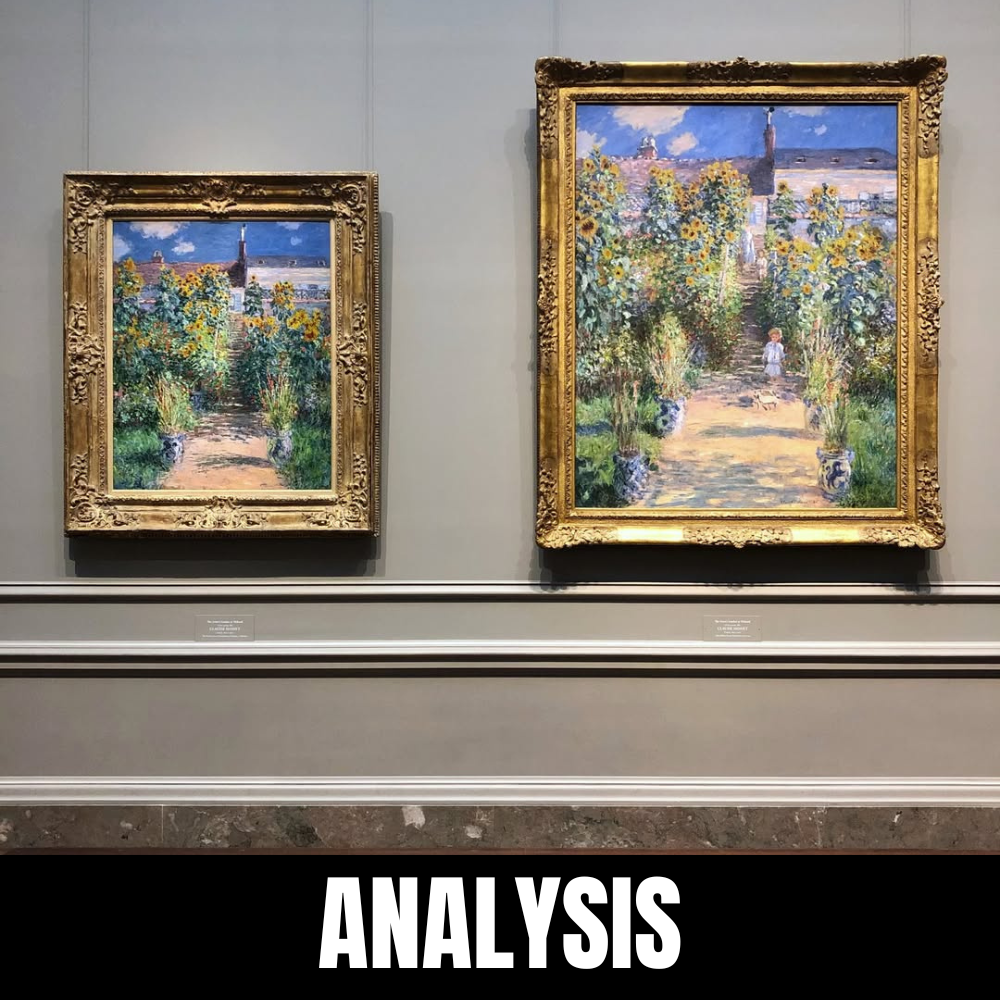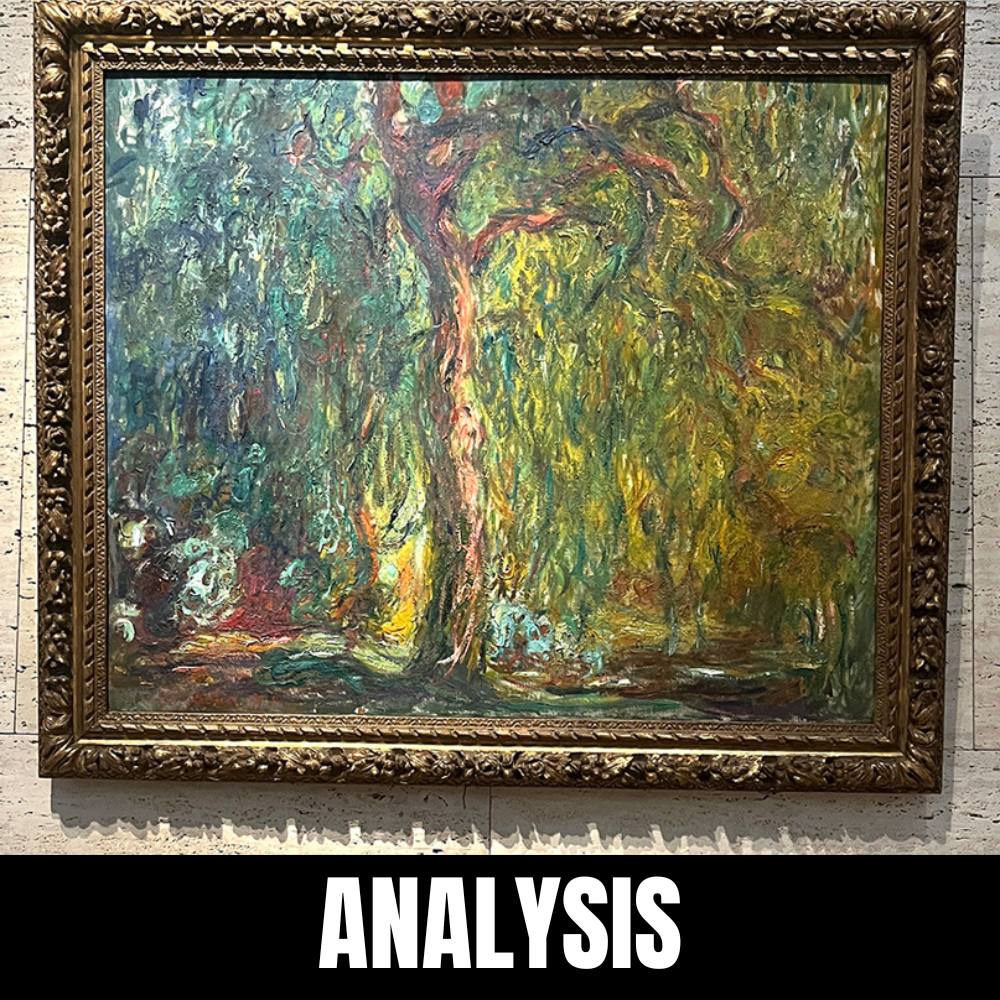Your cart is currently empty!

Phyllis and Demophoön – John William Waterhouse
Immerse yourself in the enchanting world of classical art with our highest quality oil painting reproduction of “Phyllis and Demophoön” by John William Waterhouse. This exquisite piece captures a poignant moment of love and longing, where Phyllis, adorned in flowing garments, gazes wistfully at her beloved Demophoön, who stands poised yet distant. The lush, vibrant colors and intricate brushwor…
Phyllis and Demophoön – John William Waterhouse
John William Waterhouse, an artist renowned for his evocative depictions of mythological and literary figures, captured timeless moments in history and mythology. Among his many masterpieces, Phyllis and Demophoön stands out as a beautiful example of his interpretation of classical myth and his ability to breathe life into ancient stories. Painted in 1884, this work tells the tragic yet passionate story of Phyllis, a queen in Greek mythology, and her doomed love for the young prince Demophoön.
The Story of Phyllis and Demophoön
The myth of Phyllis and Demophoön originates from Ovid’s Metamorphoses and other classical sources. Phyllis, the daughter of a Thracian king, falls in love with Demophoön, the prince of Athens. After spending time together, Demophoön promises to return to Phyllis after a journey, but when he departs, he does not return as promised. Heartbroken and abandoned, Phyllis waits for his return, growing more desperate with each passing day.
In her grief, Phyllis transforms into an almond tree, her longing and unfulfilled love turning her into the living embodiment of sorrow. The myth ends with Demophoön’s eventual return, only to find the tree, and thus his lost love, transformed forever.
Waterhouse’s painting, however, captures a moment of intense emotion and foreboding, before the final tragic transformation occurs. The painting invites viewers to witness the bond between Phyllis and Demophoön at its peak, filled with hope and passion before the heartbreak that follows.
Composition and Symbolism
1. Phyllis and Demophoön – A Moment of Passion and Despair
Waterhouse’s depiction of Phyllis and Demophoön is a tender, intimate moment between the two lovers. The couple is captured in a lush, garden-like setting, surrounded by soft, verdant foliage, with Phyllis seated on a stone bench and Demophoön standing close to her. The body language of the figures conveys the deep affection they share. Phyllis gazes up at Demophoön with an expression of longing and anticipation, while he leans in, offering his comfort and affection.
Waterhouse’s attention to detail in their faces and posture speaks to the raw emotional intensity of their relationship. The way Demophoön holds Phyllis’ hand and their eye contact suggests a strong, unspoken bond, as though their love is one filled with promise and devotion.
The soft, warm tones of their clothing – Phyllis’ flowing white gown and Demophoön’s richly detailed armor – contribute to the romantic atmosphere, while also highlighting the contrast between the purity of their love and the tragic fate that lies ahead.
2. The Setting – A Garden of Love and Foreboding
Waterhouse often uses nature and landscape to mirror the emotional states of his characters, and Phyllis and Demophoön is no exception. The lush, verdant garden surrounding the couple creates a sense of seclusion and intimacy, a private space where the lovers can express their emotions freely. The vibrant greens and subtle blooms suggest the blossoming of their love, filled with vitality and life.
However, there is also a sense of impending doom that permeates the scene. The deep shadows and the presence of an overhanging tree branch can be seen as a subtle hint at the transformation that will later occur. This dichotomy between beauty and tragedy is central to the narrative of Phyllis and Demophoön, and Waterhouse’s depiction captures this perfectly.
The garden setting is both a place of love and an enclosure, symbolizing the confines of Phyllis’ heart and the eventual isolation that she will experience when left behind. The garden acts as a metaphor for the natural world, which will bear witness to the emotional extremes of love and loss.
3. Color Palette – Light and Shadow
Waterhouse’s use of color in Phyllis and Demophoön is subtle yet powerful. The gentle, warm tones of Phyllis’ gown and Demophoön’s armor contrast with the darker shades of green in the background. This contrast highlights the couple’s radiant connection amidst the more somber undercurrents that run through the story.
The soft lighting on the figures creates a glowing effect around them, making them appear almost ethereal, while the darker corners of the painting suggest the darkness that awaits them. Waterhouse’s delicate blending of light and shadow is not only a technical achievement but also serves to heighten the emotional depth of the scene. The warmth of the couple’s figures stands in stark contrast to the shadowy space they inhabit, reinforcing the tension between the fleeting joy of their love and the darkness that is soon to come.
Themes and Interpretation
1. Love and Betrayal
At its core, the myth of Phyllis and Demophoön is one of love, betrayal, and loss. Waterhouse captures the intense emotions of the lovers at the height of their connection, but there is an underlying sense of tragedy that weaves through the scene. Phyllis’ longing gaze and the tender gestures exchanged between her and Demophoön suggest a love that is pure and genuine, yet ultimately doomed. The story speaks to the power of love, but also to the fragility of human connections. Phyllis’ subsequent transformation into a tree can be seen as a metaphor for the overwhelming emotional pain that love can cause when it is unreciprocated or betrayed.
The painting captures the emotional duality of the myth—moments of tenderness and affection, but also a deep undercurrent of impending sorrow. Phyllis’ tragic fate, while not yet realized in the scene, hovers over the composition, reminding the viewer that love can sometimes end in heartbreak.
2. The Power of Transformation
The theme of transformation is central to the myth of Phyllis and Demophoön, as well as to Waterhouse’s artistic vision. The myth concludes with Phyllis being transformed into an almond tree, a living symbol of sorrow and love unfulfilled. In Waterhouse’s painting, the transformation is not yet visible, but the presence of nature, the garden, and the figures’ connection to the environment foreshadows the ultimate metamorphosis.
The idea of transformation is symbolized in the intertwining of Phyllis and Demophoön within the lush landscape. The flowers, the vines, and the trees in the background represent the way in which love and loss can shape and alter one’s existence. Phyllis’ eventual change into a tree, forever rooted to the ground, suggests that even in the face of abandonment, the memory of love can endure, albeit in a form that is no longer human.
3. Hope and Despair
The painting captures a fleeting moment between hope and despair. Phyllis is filled with anticipation as she awaits Demophoön’s return, but there is also a sense of fragility in her stance and expression. The deep longing in her eyes and her delicate posture indicate a sense of vulnerability that contrasts with the momentary joy of their connection. The painting is infused with a sense of both hope and inevitable despair—the idea that love is a beautiful but temporary force that can fade just as quickly as it is felt.
Waterhouse’s Technique and Legacy
Waterhouse’s mastery of detail is evident in Phyllis and Demophoön. The lush greenery and vibrant flowers are rendered with a precision that is characteristic of his Pre-Raphaelite style. His ability to depict the delicate textures of fabric, hair, and the surrounding environment brings the scene to life. The soft, almost translucent quality of the figures contrasts with the more detailed depiction of the natural world, creating a visual harmony that is both dreamlike and grounded in realism.
The emotional resonance of Phyllis and Demophoön demonstrates Waterhouse’s ability to convey deep psychological and emotional states. His skillful use of light, shadow, and color adds a layer of complexity to the work, making it a timeless example of his ability to blend beauty with tragedy.
Conclusion
Phyllis and Demophoön is a powerful and evocative painting that captures the poignant intersection of love and loss. Waterhouse’s depiction of the couple in their moment of affection offers a beautiful yet tragic representation of the Greek myth. Through his masterful use of color, symbolism, and composition, Waterhouse invites the viewer into the heart of the story, creating an emotional connection to the myth that transcends time. As with many of his works, Waterhouse’s Phyllis and Demophoön continues to captivate audiences, reminding us of the beauty, fragility, and heartache inherent in love.
John William Waterhouse
John William Waterhouse was a British painter known for his enchanting depictions of mythological and literary themes, characterized by rich colors, emotional depth, and a focus on female figures that often evoke a sense of longing and beauty.





Leave a Reply